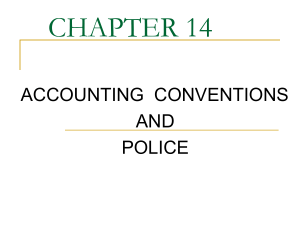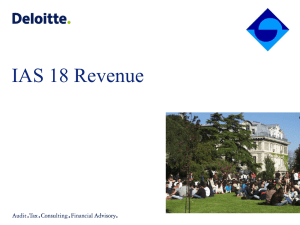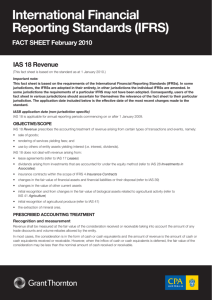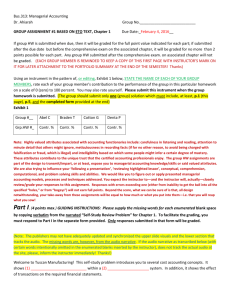Common forms of off balance sheet finance Consignment of inventory
advertisement
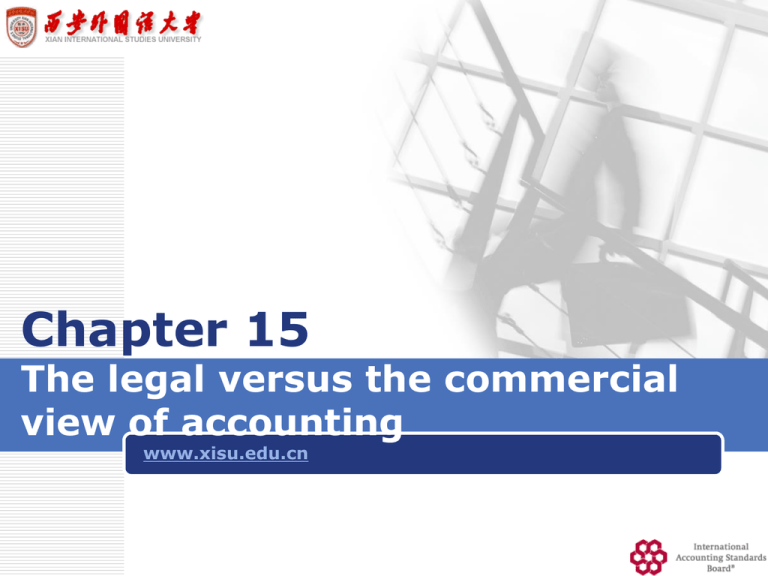
Chapter 15 The legal versus the commercial view of accounting www.xisu.edu.cn Contents 1. Off balance sheet finance 2. Substance over legal form 3. The IASB Framework 4. Common forms of off balance sheet 5. Revenue recognition Accounting standards IAS IAS IAS IAS IAS 11 17 18 24 32 Off balance sheet finance What is off balance sheet finance? Off balance sheet finance has been defined as the funding or refinancing of a company’s operations in such a way that, under legal requirements and, until relatively recently, existing accounting conventions, some or all of the finance may not be shown on its balance sheet. Off balance sheet finance Reasons as to why companies resort to off balance sheet finance? To maintain low gearing; Without it gearing will be high, suggesting that a right issue is imminent, with an adverse effect on share price; Matching borrowings with assets being developed and effectively removing both from the balance sheet; Activities such as leasing and financial services can give rise to high gearing ratios and are therefore placed off balance sheet. Diagram Off balance sheet finance To keep gearing low The purpose of off balance sheet finance To stay with the terms of loan covenants Substance over form What is substance over form? The principal that transactions and other events are accounted for and presented in accordance with their substance and economic reality and not merely their legal form (Framework) It is used to determine accounting treatment in financial statements and so prevent off balance sheet balance. And the information provided can better reflect the economic activities. Substance over form IAS17 Leases In IAS17,there is an explicit requirement that if the lessor transfers substantially all the rewards and risks of ownership to the lessee then ,even though the legal title has not necessarily passed ,the item being leased should be shown as an assets in the statement of financial position of the lessee and the amount due to the lessor should be shown as liability IAS24 Related party disclosures It requires that financial statements to disclose fully any material transactions undertaken with a related party by the reporting entity ,regardless of any price charged. Substance over form IAS11Consruction contracts It requires to account for attributable profits on construction contracts under the accruals convention. IAS27 Consolidated and separate financial statements IAS27 contains a definition of a subsidiary based on control rather than just ownership rights ,thus substantially reducing the effectiveness of this method of off balance sheet finance. Substance over form Control is the power to govern the financial and operating polices of an entity so as to obtain benefit from its activities. The control exists when: (a) the parent has a majority of the voting rights in the subsidiary (possibly by agreement with other members) (b) the parent can appoint or remove a majority of the board of the subsidiary,or (c) the parent can direct the operating and financial policies through a statute or agreement or (d) the parent can cast the majority of votes at a board meeting of directors The IASB Framework The Framework provides the general guidance for reporting the substance of transactions and preventing off balance sheet finance. You should consider these items while studying : (a) IAS17 leases (b) IAS32 Financial instruments (c) IAS27 Consolidated and separate financial statements (d) IAS24 Related party disclosures (e) IAS18 Revenue Common forms of off balance sheet finance Consignment of inventory Sale and purchase agreements Common forms of off balance sheet finance Factoring of receivables Sale and leaseback agreements Factoring of debts Common forms of off balance sheet finance Consignment inventory Consignment inventory is an arrangement where inventory is held by one party (says a distributor) but is owned by another party (for example a manufacturer or a finance company). The following apply where it is concluded that the inventory is in substance an asset of the dealer. (a) The inventory should be recognized as such in the dealer’s statement of financial position, corresponding liability to the manufacturer. (b) Any deposit should be deducted from the liability and the excess classified as a trade payable. Common forms of off balance sheet finance Sale and repurchase agreements These are arrangements under which the company sells an asset to another person on terms that allow the company to repurchase the asset in certain circumstances. If the seller has the right to the benefits of the use of the asset ,and the purchase terms are such that the purchase is likely to take place ,the transaction should be accounted for as a loan. Sale and leaseback transactions A sale and leaseback transaction involves the sale of the an asset and the leasing back of the same asset. The lease payment and the sale price are usually negotiated as a package. The accounting treatment depends on the types of lease involved. If it is a financial lease, then it is in substance a loan from the lessor to the lessee. If it is operating lease and the transaction has been conducted at fair value ,then it can be regarded as normal sale transaction. Common forms of off balance sheet finance Factoring of receivables /debts Where debts or receivables are factored, the original creditor sells the debts to the factor. The sale price may be fixed at the outset or may be adjusted later. If the seller has to pay interest on the difference between the amounts advanced to him and the amounts that the factor has received ,and if the seller bears the risks of non-payments by the debtor , then the indications would be that the transaction is, in effect, a loan. Revenue recognition Introduction Accrual accounting is based on the matching of costs with the revenue they generate. Revenue is generally recognized as earned at the point of sale, because at that point four criteria will generally have been met: (a) The product or service has been provided to the seller (b) The buyer has recognized his liability to pay for the goods or service provided (c) The buyer has indicated his willingness to hand over cash or other assets in settlement of his liability. (d) The monetary value of the goods or services has been established. Revenue recognition Revenue from specific types of transaction or events IAS 18 Sale of goods Rendering of services Interests , royalties and dividends Revenue recognition Sale of goods Revenue from the sale of the goods should only be recognized when all the following are satisfied: (a) The entity has transferred the significant risks and rewards of ownership of the goods to the buyer (b) The entity has no continuing managerial involvement to the degree usually associated with ownership ,and no longer has effective control over the goods sold (c) The amount of revenue can be measured reliably (d)It is probable that the economic benefits associated with transaction will flow to the entity (f) The costs incurred in respect of transaction can be measured reliably Revenue recognition Rendering of services (a) (b) (c) (d) The associated revenue should be recognized by reference to the stage of completion of the transaction at the end of the reporting period. The outcome of a transaction can be estimated reliably when all the following are satisfied. The amount of revenue can be measured reliably It is probable that the economic benefits associated with transaction at the end of the reporting period can be measured reliably The stage of completion of the transaction at the end of reporting period can be measured reliably The costs incurred for the transaction and the costs to complete the transaction can be measured reliably Revenue recognition Interest , royalty and dividends The revenue is recognized on the following bases: (a)Interest is recognized on a time proportion basis that take into account the effective yield on the asset (b) Royalties are recognized on an accrual basis in accordance with the substance of relevant agreement (c) Dividends are recognized when the share holder’s right to receive payment established Disclosure The following items should be disclosed. (a) The accounting polices adopted for the recognition of revenue, including the methods used t determine the stage of completion of transactions involving the rendering of services (b) The amount of each significant category of revenue recognized during the period including revenue arising from: (i) The sale of goods (ii) The rendering of service (iii) Interest (iv) Royalties (v) Dividends (c) The amount of revenue arising from exchange of goods or services included in each significant category of revenue www.xisu.edu.cn






